A decade ago, the picturesque Piran, a town on the Slovenian side of the Adriatic coast, was reported about worldwide as the first town in Eastern Europe to have a black mayor. Today, the mayor is white and the owner of a local photo shop, but black flags are still flying on the boats of local fishermen in protest of fishing restrictions in the Piran Bay imposed on them by Croatian border patrols.

Somewhere halfway between Ljubljana and the sea, the clouds are parting and the November sun is illuminating all shades of green, yellow and red in the Slovenian version of the Indian Summer.
Writer Aleksandar Gatalica is behind the wheel of a car as he tells me about his first days as a cultural adviser at the Serbian Embassy in Ljubljana. He remembers the time when he went on a summer vacation to Rovinj with his brother, sister, mother and father by train. They did not jump out of the train and throw their suitcases out the window at the Kanfanar station like the students described in Mišo Jovanović’s book “Goodbye to the Old Rovinj”, which I wrote about in this magazine two months ago. They would go to Pula, have breakfast in the park and wait for the bus to Rovinj.
Today, almost no one takes a train to go on vacation in Istria – the new Croatian and Slovenian motorways and airports on the island of Krk, in Pula and Portorož are sufficient to transport everyone who wants to spend their vacation in the most developed tourist region in the former Yugoslavia.
We pass the turn for Trieste, a little later for Koper and through the “tunnel” created by centuries-old conifers, we enter Piran. The already mentioned love that people from Belgrade have for Istria has given rise to a very special relationship that the so-called Balkan Marketing King, Dragan Sakan and the town of Piran had.
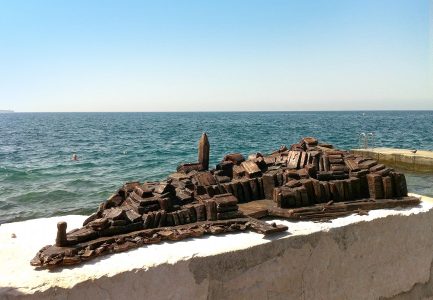
On the Piran waterfront, on a two-meter high rampart, a monument was erected that resembles a stylized version of Piran made of books, pencils, rulers… The monument has been designed by Slaviša Savić and made by the sculptor Milan Stošić. Thus conceived bronze memory of Dragan Sakan symbolizes his motto – “Ideas are all around us” – as well as the inspiration and respect he and Piran had for each other ever since he had launched his school of ideas ‘Ideas Campus’, a gathering place for the greatest creatives of his time.
We left the car in the parking lot between the Piran Hotel and Partizanska Street and headed to the City Hall. The winged lion of St. Mark testifies that the town was ruled by Venice for more than five centuries (Ah, those five centuries!) – from 1283 until the fall of the Venetian Republic in 1797.
Until 1918 (except for the short French rule from 1806 to 1814), Piran was under Austrian rule. During that French rule, a naval battle took place near the town between the English and French warships. It was called the Battle of Piran, which ended in Napoleon’s defeat.
Between the two world wars, Piran was part of the Kingdom of Italy, and from 1947 to 1954, was part of Zone B in the disputed territory between Italy and Yugoslavia. “Zone A and Zone B belong to both of our beings”, it was sung at rallies throughout Yugoslavia. In the end, Zone A, which included the city of Trieste, became part of Italy and Zone B, which included Piran, came under the Federal People’s Republic of Yugoslavia. Since 1991, Piran has been part of the independent Republic of Slovenia, and on the same balcony next to the Lion of St. Mark four flags hang – the City of Piran’s, the EU’s, Slovenian and Italian.
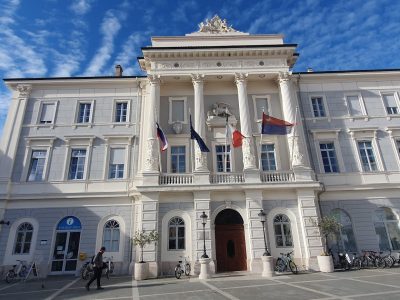
We put on our masks and enter the City Hall. The guard asks us for our COVID-passes and after a few minutes, we end up in the office of Djeni Zadković (age 57), the mayor of Piran. He tells us how he completed his conscription in Kosovska Mitrovica during the time of the former Yugoslavia. Two years ago, he was on an official visit to Belgrade and met with Mayor Zoran Radojičić. in cooperation with three coastal Slovenian municipalities – Koper, Izola and Ankaran – the municipality of Piran is a candidate for the European Capital of Culture 2025.
We are talking about potential cooperation in the promotion of Piran in Serbia, and the mayor tells us that 40% of the money from the sojourn taxes is paid by the city to the local association of hoteliers, which then makes decisions on which project to support. Transferring cash flows from the hands of politicians to the hands of the business community is quite unusual for towns south of Zidani Most.
“LET THEM TALK”
A giant painting “Mary with the Child and the Signs of Piran”, the work of Domenico Tintoretto (1560-1635), a Venetian painter and son of the much better known Jacopo Tintoretto, adorns the ceremonial hall of the City Hall.
As we were leaving, a gallery of photographs featuring former mayors of Piran caught my eye in the hallway. The latest in a series is Peter Bosman, “the first black mayor in Eastern Europe” and “Piran’s Obama”, as he was called by the world media when he was elected to that position in 2010.
Peter arrived in Yugoslavia in the late 1970s, after the army’s coup d’état in his native Ghana. When he came to Ljubljana, he knew nothing about the city, but he soon fell in love with it as well as the whole of Slovenia. “When we were supposed to return to Ghana, it was destiny who brought my patients in Piran together, who launched a petition, asking the authorities to let me stay. They called me a ‘black angel’,” said Bosman, who headed the city in two terms from 2010 to 2018. I am trying to imagine a city in Serbia, Bosnia or Croatia which has had a black mayor for two terms and followed by a mayor who is also the owner of a local photo shop.
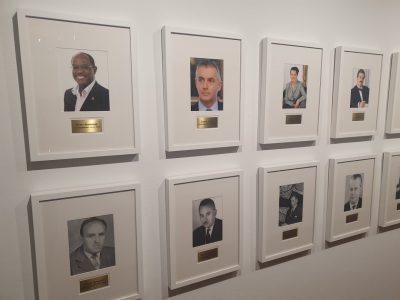
We leave the City Hall and sit on the terrace of one of the cafes in Tartini Square, named after the 18th-century Venetian composer and violinist Giuseppe Tartini, who was born in this town. In addition to the City Hall, there are several other interesting buildings in the square, such as the birthplace of the aforementioned famous composer and the Church of St. Petra. In the northern part of the square is the Venetian House, which according to a myth was built by a rich Venetian merchant for his much younger mistress. On its facade, he ordered relief to be made with the inscription in Latin – “Lassa pur dir” (“Let them talk!”).
Speaking of Venetians and considerably younger mistresses, I remembered Miroslav Krleža’s play ‘The Glembays” and the excerpt from it: “That woman was worth more than seventy thousand other women! I bought her a three-story house in Vienna. Yes, I bought it, but what if I bought her a three-story house and if all my staff knew about it? No three-story house can match that heart, that vitality, that culture, that youth.”
The square also has the Loggia, where in ancient times, the wealthiest townsmen met. Today, there is an art gallery, which is one of the biggest attractions of Piran. The oldest building here is the abovementioned House of Tartini, built in Gothic style. The building was restored from 1985 to 1991 and is now managed by the local Italian community. A small museum, the memorial house of Giuseppe Tartini, is located on the ground floor.
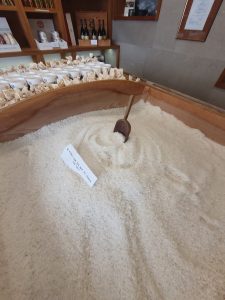
Aleksandar tells me that the square where we are sitting used to be a port, but the water, just like in Venice, severely eroded the foundations of the surrounding houses, so they decided to cover the marina with stone and soil, build a square in its place and move the port a hundred meters to the sea.
After finishing my coffee, I went to the Piran Salt Pans store, which sells various products that contain the famous Piran salt. I opt for salty chocolate. It’s lunchtime and we are slowly moving towards Prešeren’s embankment, a street along the coast that abounds in restaurants. The fortune-teller recommends the tried and tested Three Widows restaurant. After a serving of stuffed squid paired with fried squid and homemade Malvasia, we were ready to go to the next meeting in neighbouring Portorož.
THE KEMPINSKI BAY
As we drive past the harbour, I spot a multitude of small black flags on fishing boats. My companion explains to me that this is a symbol of the protest of local fishermen who have been facing numerous problems with the Croatian Coast Guard for years. Namely, it is about the still unresolved Slovenian-Croatian border dispute over a part of the sea which the Slovenes call the Piran Bay and the Croats – the Savudrija Bay. Someone witty came up with a new name – the Kempinski Bay since famous Kempinski hotels sit on both sides of the bay – the Kempinski Palace in Portorož, Slovenia, and Kempinski Adriatic Istria in Savudrija, Croatia. Both operate under the MK Group, owned by the Serbian businessman Miodrag Kostić.
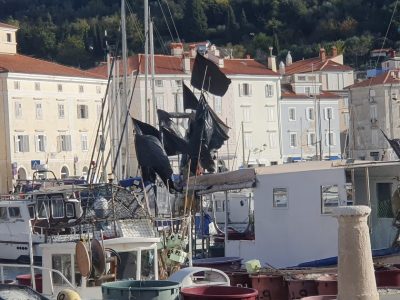
The Kempinski Palace Hotel in Portorož, a trademark of the Slovenian coast, was opened in 1908 during the “golden age” of Habsburg rule in this area. It was designed by the Austrian architect Johann Eustachio. At the end of the summer season of 1990, the hotel was closed, but the war the following year kept it locked up for the next 18 years. After obtaining a license from the international hotel chain Kempinski and renovation worth 70 million euros, the hotel reopened on October 18, 2008.
Six kilometres south of Portorož, next to the village of Sečovlje and only 300 meters from the Croatian border, is the smallest of three Slovenian airports. The runway is 1,205 metres long, and smaller aircraft, sports planes, private jets and ATRs are currently allowed to land on it. There are plans to extend the runway by another 400 metres, which would be fit for the Boeing 757. However, that would disturb farming here as farms border the airport. Local authorities are reluctant to disrupt the environmental balance, and cattle and goats grazing on pastures near the runway. I am trying to imagine how this problem would be solved in some other countries in the region.
After the meeting in Portorož, our car glides on a perfectly maintained motorway towards overcast Ljubljana, leaving the sign for Trieste to our left. Zone A and Zone B are together again in a united Europe, and alls we, south of Zidani Most, can do is to think about it until the next missed opportunity.